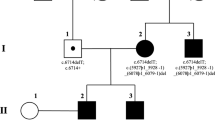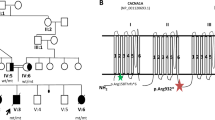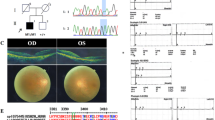Abstract
IT is a striking fact that in many inherited human pathological conditions more than one type of inheritance is found. To quote only two examples, retinitis pigmentosa may be either dominant or recessive, and congenital stationary night blindness may be dominant, recessive, or sex-linked.1 In a collection of human pedigrees of a condition showing dominant inheritance there is no possibility of determining whether a single dominant factor is involved in all cases, or whether the condition may be determined by any one of several dominant factors. This is also true of sex-linked inheritance, but in the case of a condition which behaves as a recessive, a test is available. The incidence of first-cousin marriages amongst the normal parents of affected offspring can be related to the incidence of the condition in the general population. The formula in use was proposed by Lenz2 and Dahlberg.3
This is a preview of subscription content, access via your institution
Access options
Subscribe to this journal
Receive 51 print issues and online access
$199.00 per year
only $3.90 per issue
Buy this article
- Purchase on SpringerLink
- Instant access to full article PDF
Prices may be subject to local taxes which are calculated during checkout
Similar content being viewed by others
References
Hogben, J. Genet., 25; 1931.
Lenz, Münch. Med. Wochen., 66; 1919.
Dahlberg, Hereditas, 14; 1930.
Pearson, Usher and Nettleship, Drapers Co. Res. Mem., 1–4; 1913.
"Treasury of Human Inheritance". 2; 1922.
Sjögren, Hereditas, 14; 1930.
Hogben, Worrall and Zieve, Proc. Roy. Soc. Edin 52; 1932.
Author information
Authors and Affiliations
Rights and permissions
About this article
Cite this article
ROBERTS, J. Human Pathological Conditions Determined by Any One of Several Genes. Nature 130, 542–543 (1932). https://doi.org/10.1038/130542a0
Issue date:
DOI: https://doi.org/10.1038/130542a0
This article is cited by
-
The genetic basis of amaurotic family idiocy
Journal of Genetics (1933)



